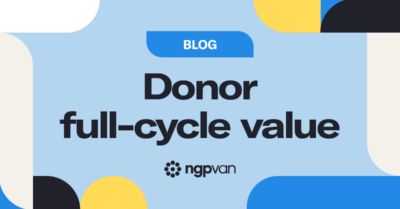How to Create a Political Campaign Website

Whether you’re running for Congress, county clerk, city council, or some other office, you need to build a website to help increase your digital presence so prospective supporters can find more information and ways to take action for your campaign. With people spending more time online and on their phones searching for information, implementing a digital strategy to attract and engage supporters online should be a key part of your campaign plan. One of the best ways to establish a digital presence is to create a compelling campaign website to share more about yourself and your campaign.
What is the Purpose of a Political Campaign Website?
The purpose of a political campaign website is to serve as a central platform for candidates to communicate their message, values, and policy positions. It’s also a place where prospective and existing supporters can go to donate to the campaign or find opportunities to volunteer. Your website should serve as a one-stop shop for people to learn more about you, your campaign, and how they can help you get elected.
How to Create a Campaign Website in 6 Easy Steps
Whether you’re a web expert or a coding novice, you can build a campaign website (or we can design one for you!) to expand your digital footprint. By following these six steps, you’ll build a website that can help you effectively communicate your priorities, raise money, reach voters, and make progress toward your campaign goals.
Step 1: Define Your Goals
Before you start building your website, clearly define your goals so you understand the functionality your website should have to achieve those goals. Do you want to raise awareness about your campaign? Or generate donations? Or recruit volunteers? While impactful campaign websites will do all of these things and more, you want to make sure that you define them so you know what you need to include in your website’s design and functionality. It’s also usually a good idea to develop SMART (Specific, Measurable, Achievable, Reasonable, and Time-Bound) goals when you can. An example of a SMART goal is: “We want to have 50 people submit our volunteer form within the next month.” SMART goals will make it easier to measure progress toward your goals and optimize your work and processes if needed.
You’ll also want to consider your target audiences when you’re defining your goals. Whether you need to persuade voters, mobilize supporters, or inspire donors, make sure to frame your goals through those needs to determine how you build your web pages. For example, supporters don’t need to be convinced to vote for your campaign, but they may need to be encouraged to help share your message with other voters. Share all the ways they can get involved on your campaign on a page or form to help them find an opportunity to level up their engagement with your campaign.
Step 2: Choose a Domain Name and Hosting Platform
Your website domain is what people will search for to find more information about you or enter your website. For instance, ngpvan.com is the domain for our website. You should consider choosing a domain name that’s easy to remember and aligns with your candidate’s name or message. You could also have it mirror your social media usernames to make it easier to reference and remember. Domains work in tandem with hosting platforms to make a website accessible online.
Hosting platforms support the infrastructure and resources you need to actually create a website that users can access and engage with. These platforms will store images, copy, web pages, and more to ensure your website functions and appears as it should. When choosing a hosting platform, stick with a reputable and reliable hosting platform that offers sufficient bandwidth and storage to accommodate your website’s needs. After choosing your domain and hosting platform, it’s time to design your website.
Step 3: Design a Visually Appealing Layout
Creating a visually engaging website is one key way to help keep people on your website longer, encourage them to explore other pages, and offer a great user experience when they’re learning more about you and your campaign. As you begin building your website, you’ll likely start with a template website that you can customize for your campaign needs. However, you should make sure that the template is responsive, meaning that it adapts seamlessly to different screen sizes, ensuring optimal viewing and navigation across device types. You can also choose to build your campaign website from scratch if you have the time and expertise to do so!
As you build out your website, organize its structure and navigation intuitively to make it easier for visitors to find the information they are looking for quickly. Most websites contain a menu or navigation bar at the top (known as the header) so users can easily navigate throughout the website. This navigation bar is usually built around the outline of your website and directs people to key pages on your website. At the bottom of the page (known as the footer), campaigns will often create another navigation area (known as a sitemap footer) that offers another opportunity for users to find links to important pages. Campaigns also usually place any disclaimers required by relevant campaign finance laws in the footer. Headers and footers usually do not change between pages on your website.
Between the header and footer, the body of the pages will contain the bulk of your content, which will likely change between pages. Most of your multimedia elements, designs, and customizations will be housed in the body sections as well. Ensure that these multimedia elements are optimized (especially high-resolution photos or other large media files) to help maintain site speed. Within your body sections, you’ll also want to incorporate header tags, keywords, and relevant links to help your pages rank higher in search results. Adding these elements is also known as search engine optimization, and we will discuss it in more detail later in the blog.
As you build your website, work through the various pathways people may take when they visit. For instance, if someone is coming to learn more about your campaign, sign up to volunteer, or donate, each of those activities has a different pathway that you should test to ensure everything works as it should. Now that you’ve chosen your template and learned about some of the main components of the website, it’s time to start developing your content.
Step 4: Craft Compelling Content
Writing content for your website may be one of the most time-consuming parts of creating your website, but it’s also one of the most worthwhile things you can do. You will need to create several pages of relevant content that explains who you are, where you stand on the issues, and how people can support your campaign.
Sharing your story and what inspired you to run for office will help you create your biographical page. This page should introduce your background, and values, and share why you’re running for office. By adding this information, you help prospective supporters learn more about you as a person and make the case as to why you’re the best candidate in the race.
You’ll also want to create a page to share where you stand on the issues. This page will usually contain high-level statements or phrases summarizing your position on important issues and then have more in-depth explanations below them or on a different page. Feel free to add as many issues as you want, but it’s usually best to focus on a few you designate as the most important for your campaign. It may also benefit your campaign to add a form at the bottom of the page that encourages people to reach out if they have questions about where you stand on particular issues that may not be on the page.
In addition, you should create a page where people can find out how to get involved in your campaign. Whether it’s a link to your events on Mobilize (the leading volunteer recruitment and event management platform), a simple volunteer sign-up form, or something else, you want to have something on your website that prospective volunteers can use to indicate they want to help your campaign!
You may want to create another page to share blogs, updates, and press releases too. This page can help you share important information with visitors to your website, like endorsements, announcements, and more. Plus, having a news or media page can also make it easier to keep your website updated with new and relevant information.
Throughout these pages, consider using multimedia elements like photos, videos, and infographics to help increase engagement and illustrate key messages. For example, if you find your opponent only had 10 people donate to their campaign, but hundreds of people contributed to yours, you could make a bar graph to compare your support to theirs. Or if you started airing your first digital ad across your district, consider adding that to your website too!
Step 5: Optimize for Search Engines
As you create new content, you’ll also want to optimize your website for search engines to enhance online visibility through search engine optimization (SEO). As we mentioned earlier, you can incorporate header tags, keywords, and relevant links to help boost your web pages in search results. If you want to learn more about SEO, there are tons of free articles and tools online to help you improve your ranking and hopefully drive more relevant traffic to your website!
You can also utilize analytics tools to track visitor data and behavior on your site to help inform future changes and developments. For example, if people are spending lots of time on your biographical or issues pages, but aren’t moving over to your volunteering page, try adding a few more links to encourage people to learn how to get involved on those other pages. You can also analyze user behavior to identify if there are ways to improve the user experience to keep people engaged on your website.
Step 6: Integrate a Donation Form
Integrating a donation form into your website provides a convenient way for supporters to contribute financially to your campaign. Using an online donation platform, you make it easier for supporters from around your community, region, or state to provide the resources you need to run your campaign effectively. Some donation platforms even allow users to quickly create reports and dashboards to show progress toward their fundraising goals.
Lightboxes can also be helpful to generate additional engagement on your website as well. These pop-up windows usually appear a few seconds after someone enters your website. They can encourage people to donate, watch a video, sign up for your email list, or something else. Adding a lightbox to your website may help increase the visibility of your donation page or form and hopefully lead to additional donations too!
Invest in a Political Campaign Website Builder
After reading through this blog, you should have a solid understanding of the key elements of your website, the factors you should consider when building it, and some of the technical measures you’ll need to navigate through to build your website. While some may be able to build their websites, it can take valuable time away from other pressing campaign priorities like raising money or talking to voters. Or, if you haven’t built a website before or you aren’t the most tech-savvy person, it may be confusing and overwhelming to create one.
If you’d rather leave it to the professionals, consider hiring someone to create your campaign website for you. They’ll be able to help you develop a compelling and engaging website that helps attract more traffic and motivates supporters to learn more and take action. Plus, they can handle the technical components to set your website up for success. However you choose to build your website to expand your digital footprint, make sure that it helps you communicate your priorities, raise money, reach voters, and make progress toward your campaign goals. Once you publish your website, check it regularly and update it with relevant content when needed to keep it current and running smoothly. And remember: your website is one of the first things prospective supporters may see, so make sure it looks and works just as you’d expect to make sure they have a positive first impression of your campaign!




